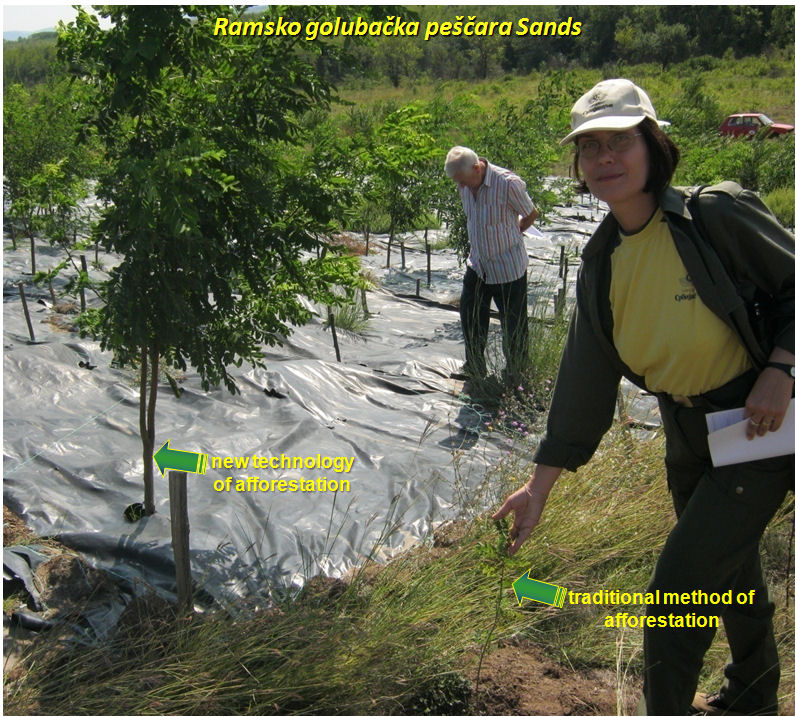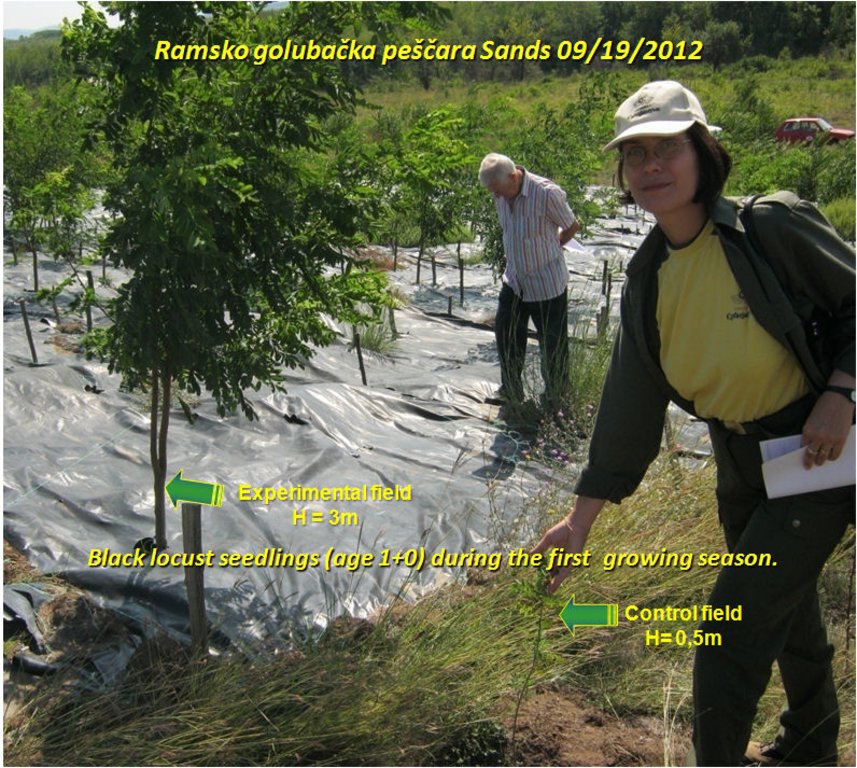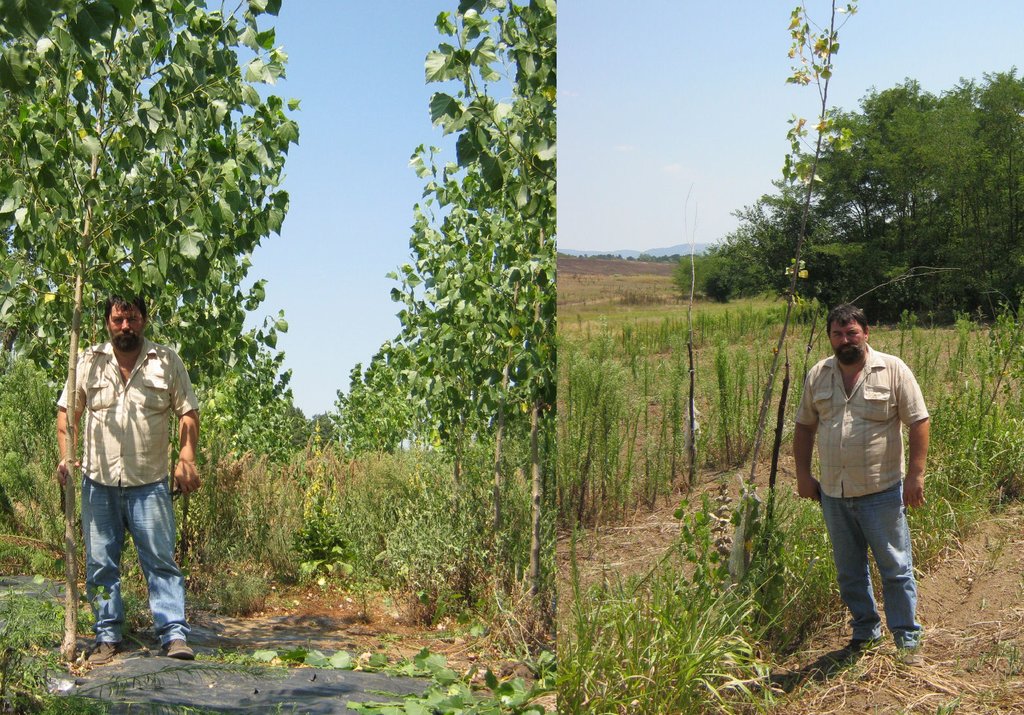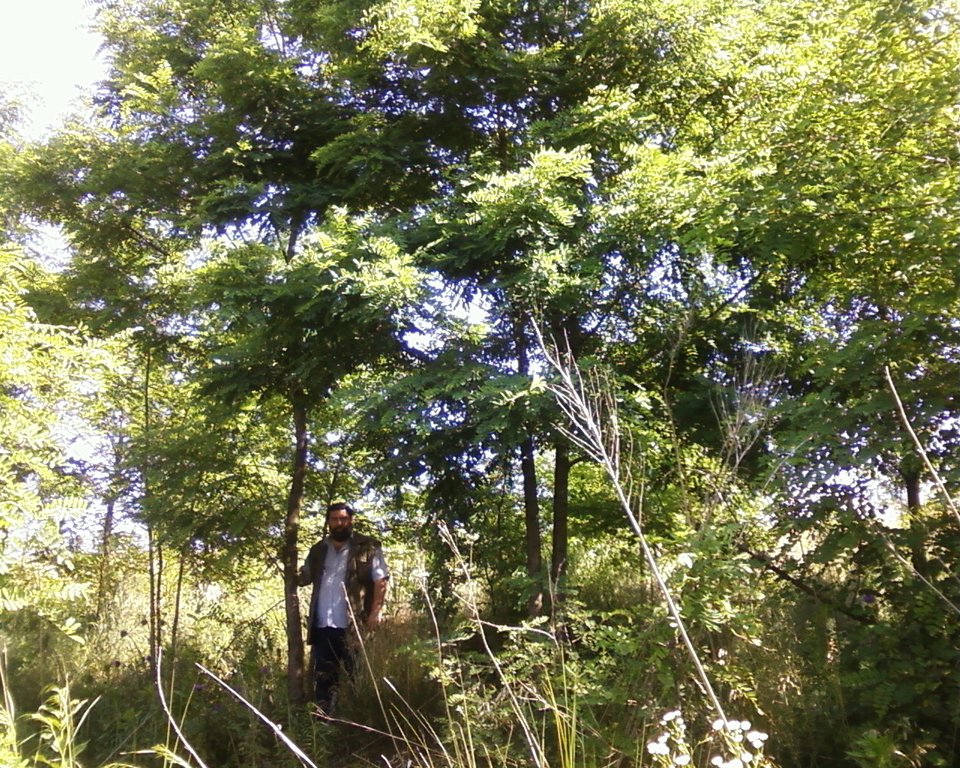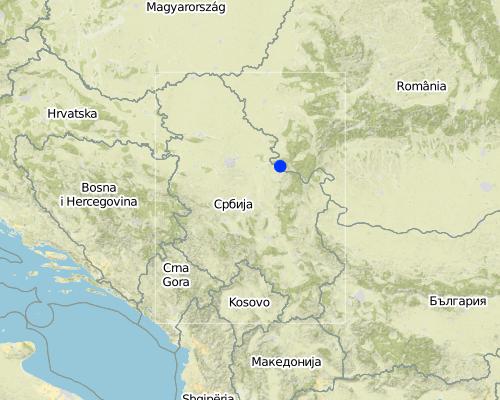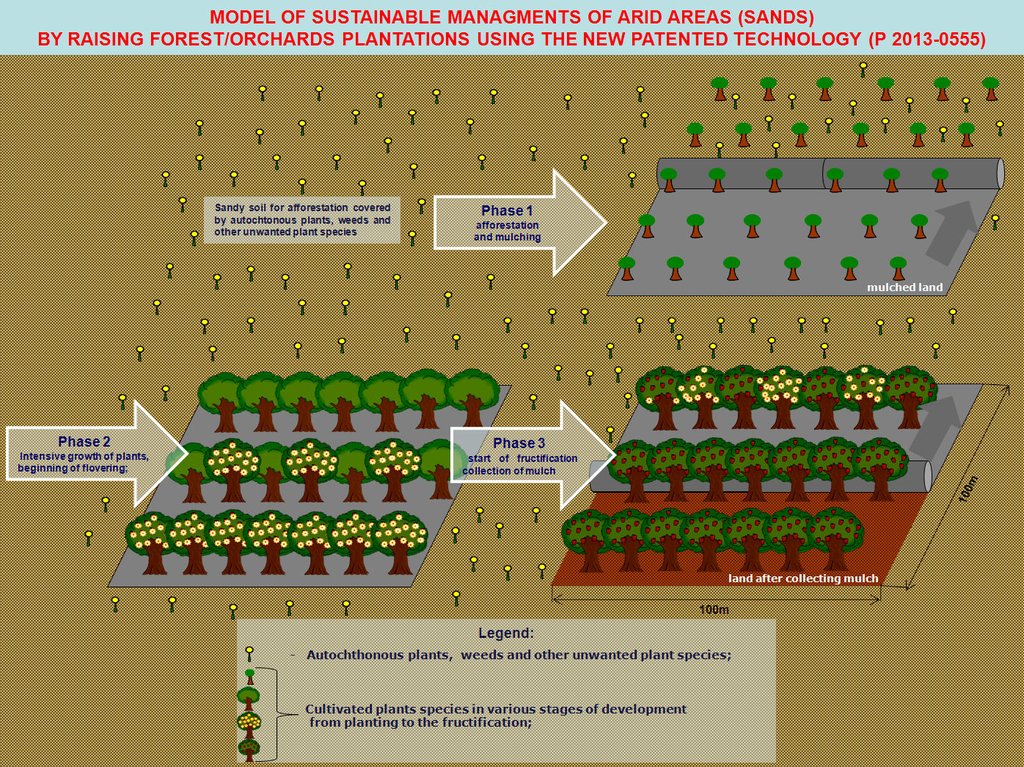New patented technology of raising forest and orchards in the extremely unfavorable environmental conditions [Serbia]
- Creación:
- Actualización:
- Compilador: Blagoje Pejić
- Editor: –
- Revisor: Alexandra Gavilano
The Procedure Complete Mulching of Land In Order to Raise Young Plantations of Woody Plants Under Unfavorable Climate Conditions P 2013 - 0555
technologies_500 - Serbia
Visualizar secciones
Expandir todo Colapsar todos1. Información general
1.2 Detalles de contacto de las personas de referencia e instituciones involucradas en la evaluación y la documentación de la Tecnología
1.3 Condiciones referidas al uso de datos documentados mediante WOCAT
¿Cuándo se compilaron los datos (en el campo)?
19/09/2012
El compilador y la/s persona(s) de referencia claves aceptan las condiciones acerca del uso de los datos documentados mediante WOCAT:
Sí
1.4 Declaración de la sostenibilidad de la Tecnología descrita
¿La Tecnología aquí descrita resulta problemática en relación a la degradación de la tierra, de tal forma que no puede considerársela una tecnología sostenible para el manejo de la tierra?
No
Comentarios:
This technology does not pollute the environment and completely excludes the use of chemical agents in the control of undesirable plant species.
2. Descripción de la Tecnología MST
2.1 Breve descripción de la Tecnología
Definición de la Tecnología:
The technological process of complete mulching with specific materials (P 2013 – 0555) has a positive impact on the development, e.g. the growth intensity and the growth time of the cultivated plant species. This technology allows to grow plants without additional irrigation in rather poor habitat conditions (high temperature, insolation, etc.).
2.2 Descripción detallada de la Tecnología
Descripción:
1. This technology has been applied in arid conditions Ramsko golubačka peščara Sands (East Serbia). This semi deserts is one of three located in Serbia. As is known, all the ecosystems (agro, forest and water ecosystems) in the surrounding of sands and deserts are highly endangered by wind erosion, which causes movement and transport of the sand and damage to people, agronomy and biodiversity. This is poor area, inhabited by the Roma population - highly affected by the consequences of moving sands;
2. This process of complete mulching of land with specific polyethylene foil enables use of poor habitat conditions (high temperature, insolation and etc) tor a positive impact on the development of plants. This innovative technology provides fully use of the reserves of moisture and mineral matters in the soil, as well as intensification of the process of photosynthesis of cultivated plants, which are the main reasons for the rapid growth and exceptionally good overall condition of young plantations
3 The purpose of this technology is to increase success of the procedure and ensure the achievement of the targeted functionality of woody plants (binding and greening sands, ensuring of food and wind shelter for humans and wild animals, increasing biodiversity) in a much shorter period of time than traditional methods afforestation.
4. In relation to the works that follow the classical techniques to raise woody plants, for this patented technology is necessary to additionally provide a trained workforce for the setting up of mulch, specific material for mulching and license to use the patent. To establish this technology trained workforces are required to set up the specific materials for mulching, taking care of the plants, as well a license to use the patented technology must be acquired
5. Based on the principle “make it and leave it” this technological process enables the following conditions: no need for additional irrigation; no need for mechanical soil cultivation before afforestation; no need for additional manpower and works that are required in maintaining young forest plantations raised by classical methods of afforestation (hoeing, inter-row processing, harrowing, weeds and stump sprout removing...); in the next 3-5 years completely prevented the appearance of unwanted species of plants (weeds) without the use of chemicals; no environmental pollution; no soil erosion as well as rinsing and removal of humus on slopes; fructification of fruit tree species starting earlier, shelterbelts and snow protective belts are usable for far less time, the sands bind is faster, afforestation of degraded land and the process of rehabilitation and recultivation is shortened, production cycle of energy crops takes less time and give faster return on investment, binding of sands and stop wind erosion has a positive impact on the microclimate of whole sandy area and helps to increase the biodiversity as well as increase of yields of agricultural crop.
6. Although the cumulative amount of costs of implementing the patented technology is much lower compared to the works following the classic techniques to raise woody plants, an aggravating circumstance for the use of this technology may be the obligation to hold a license to use the patent and greater capital investment in the first year of plantation. Users especially likes fact that young plantations reaches the targeted purposes for drastically shorter time, without additional irrigation.
2.3 Fotografías de la Tecnología
Comentarios generales sobre las fotos:
The pictures show the difference between the results of the use of traditional technology of afforestation and the use of new patented technologies of afforestation
2.5 País/ región/ lugares donde la Tecnología fue aplicada y que se hallan comprendidos por esta evaluación
País:
Serbia
Región/ Estado/ Provincia:
Veliko Gradište
Especifique más el lugar :
Ramsko golubačka peščara Sands
Map
×2.6 Fecha de la implementación
Si no se conoce el año preciso, indique la fecha aproximada:
- hace menos de 10 años (recientemente)
2.7 Introducción de la Tecnología
Especifique cómo se introdujo la Tecnología:
- durante experimentos/ investigación
3. Clasificación de la Tecnología MST
3.1 Propósito(s) principal(es) de la Tecnología MST
- mejorar la producción
- reducir, prevenir, restaurar la degradación de la tierra
- conservar el ecosistema
- proteger una cuenca hidrográfica/ áreas corriente abajo – en combinación con otras Tecnologías
- preservar/ mejorar biodiversidad
- reducir el riesgo de desastres naturales
- adaptarse al cambio climático/ extremos climáticos y sus impactos
- mitigar cambio climático y sus impactos
- crear impacto económico benéfico
- crear impacto social benéfico
3.2 Tipo(s) actuales de uso de la tierra donde se aplica la Tecnología

Bosques
Plantación de árboles, reforestación:
- Monocultivo variedad local
- Variedades mixtas
- Forest fruits plantations
Productos y servicios:
- Leña
- Frutos y nueces
- Otros productos forestales
- Conservación/ Protección de la naturaleza
3.3 Información adicional sobre el uso de tierras
Provisión de agua para la tierra donde se aplica la Tecnología:
- de secano
Comentarios:
This technological process exclude additional irrigation and provide enough moisture for the life of cultivated plant species without the need for irrigation young plants, relying only on the water from atmospheric precipitates.
Número de temporadas de cultivo por año:
- 1
3.4 Grupo MST al que pertenece la Tecnología
- manejo de plantación forestal
- rompevientos/ cinturones de protección
- cobertura de suelo/ vegetal mejorada
3.5 Difusión de la Tecnología
Especifique la difusión de la Tecnología:
- distribuida parejamente sobre un área
3.6 Medidas MST que componen la Tecnología

medidas estructurales
- S6: Muros, barreras, vallas, cercas
- S11: Otros
3.7 Principales tipos de degradación de la tierra encarados con la Tecnología

erosión de suelos por agua
- Wt: pérdida de capa arable/ erosión de la superficie

erosión de suelos por viento
- Et: pérdida de capa arable
- Ed; deflación y deposición
3.8 Prevención, reducción o restauración de la degradación de la tierra
Especifique la meta de la Tecnología con relación a la degradación de la tierra:
- prevenir la degradación de la tierra
- restaurar/ rehabilitar tierra severamente degradada
Comentarios:
This is applicable model to combat desertification and sustainable management of Sands, using by the new technology of raising forest (and orchards) in arid areas, which ensure the achievement of the targeted functionality of woody plantations in a much shorter period of time than traditional methods afforestation, without additional irrigation, just relying on the existing atmospheric sediment
4. Especificaciones técnicas, actividades de implementación, insumos y costos
4.1 Dibujo técnico de la Tecnología
4.2 Especificaciones técnicas/ explicaciones del dibujo técnico
This patented technological process of complete mulching of land enables use of poor habitat conditions (high temperature, insolation and etc.) for a positive impact on the intense growth and development of cultivated species of plants and provides, even in harsh environmental conditions, successful establishment of forest and orchards plantations, planting of new forests in areas where in the past did not exist and the conversion of stands of lower quality in higher silvicultural form, all without additional irrigation.
The news is a specific and layered process laying mulch and full coverage of land with specific, impermeable to water and light, synthetic materials over large areas. In this way, planted trees provides full access to the existing reserves of moisture and nutrients in the soil and suppress weeds, without the use of herbicides and pesticides and without the need for irrigation young plants, relying only on the water from atmospheric precipitates.
After completion of the production cycles, all the material used for mulching will be collected and recycled, which confirms that new technology has a zero degree of environmental pollution.
4.3 Información general sobre el cálculo de insumos y costos
Especifique cómo se calcularon los costos e insumos:
- por área de Tecnología
Indique tamaño y unidad de área:
1ha
otra / moneda nacional (especifique):
€ (Euro)
Indique el costo promedio del salario de trabajo contratado por día:
35€ (gross amount)
4.4 Actividades de establecimiento
| Actividad | Tipo de medida | Momento | |
|---|---|---|---|
| 1. | Marking and measuring of places for planting | Agronómicas | 2 workers (8hours) |
| 2. | Digging a hole for planting (40cm x 40 cm) | Agronómicas | 11 workers (8hours) |
| 3. | Delivery seedlings | Agronómicas | 4 workers (8hours) |
| 4. | Planting seedlings | Agronómicas | 8 workers (8hours) |
| 5. | Placing (stacking) of mulch | Otras medidas | 12 workers (8hours) |
4.5 Costos e insumos necesarios para el establecimiento
| Especifique insumo | Unidad | Cantidad | Costos por unidad | Costos totales por insumo | % de los costos cubiertos por los usuarios de las tierras | |
|---|---|---|---|---|---|---|
| Mano de obra | workers | person - days | 37,0 | 35,0 | 1295,0 | |
| Mano de obra | skilled labor force | person - days | 3,0 | 100,0 | 300,0 | |
| Equipo | Machine hours | working hours | 10,0 | 15,0 | 150,0 | |
| Equipo | Tools | kom | 10,0 | 10,0 | 100,0 | |
| Material para plantas | Seedlings | kom | 1300,0 | 1,0 | 1300,0 | |
| Fertilizantes y biocidas | Zeolite | kg | 910,0 | 0,32 | 291,2 | |
| Material de construcción | Material for mulching | square meter | 10000,0 | 0,22 | 2200,0 | |
| Otros | Licence | ha | 1,0 | 500,0 | 500,0 | |
| Otros | Transport of seedlings | Euro | 1300,0 | 0,01 | 13,0 | |
| Otros | Transport of workers | Euro | 37,0 | 0,7 | 25,9 | |
| Costos totales para establecer la Tecnología | 6175,1 | |||||
Comentarios:
The amount of the costs of raising young plantations (forest and orchard) refers to a period of 5 years, as planned duration of mulch. Based on the principle “make it and leave it”, during the period of duration of mulch, this technological process enables the following conditions: NO NEED for additional irrigation - provide enough moisture for the life of cultivated plant species without the need for irrigation young plants, relying only on the water from atmospheric precipitates; NO NEED for mechanical soil cultivation before afforestation; NO NEED for additional manpower and works that are required in maintaining young forest plantations raised by classical methods of afforestation (hoeing, inter-row processing, harrowing, weeds and stump sprout removing...). In the next 5 years completely prevented the appearance of unwanted species of plants (weeds) without the use of chemicals; NO environmental pollution; NO soil erosion as well as rinsing and removal of humus on slopes.
4.6 Actividades de establecimiento/ recurrentes
| Actividad | Tipo de medida | Momento/ frequencia | |
|---|---|---|---|
| 1. | Maintenance of mulch | Otras medidas | 3 workers (8hours) |
4.7 Costos e insumos necesarios para actividades de mantenimiento/ recurrentes (por año)
| Especifique insumo | Unidad | Cantidad | Costos por unidad | Costos totales por insumo | % de los costos cubiertos por los usuarios de las tierras | |
|---|---|---|---|---|---|---|
| Mano de obra | workers | person - days | 3,0 | 35,0 | 105,0 | |
| Indique los costos totales para mantenecer la Tecnología | 105,0 | |||||
5. Entorno natural y humano
5.1 Clima
Lluvia anual
- < 250 mm
- 251-500 mm
- 501-750 mm
- 751-1,000 mm
- 1,001-1,500 mm
- 1,501-2,000 mm
- 2,001-3,000 mm
- 3,001-4,000 mm
- > 4,000 mm
Especifique el promedio anual de lluvia (si lo conoce), en mm:
420,00
Especificaciones/ comentarios sobre la cantidad de lluvia:
Precipitation are distributed unfavorably for the planted seedlings, given that the largest deficit was recorded in the middle of the growing season.
The sum of annual insolation (average for the period 1981-2010) = 2073.8h;
Average temperature (average for the period 1981-2010) = 11.3ºC
Indique el nombre de la estación metereológica de referencia considerada:
Meteorological station Veliko Gradište
Zona agroclimática
- semi-árida
According to Lang's classification, the researched area of Ramsko golubačka peščara Sands belongs into the category of semi arid climate areas (55.5)
5.2 Topografía
Pendientes en promedio:
- plana (0-2 %)
- ligera (3-5%)
- moderada (6-10%)
- ondulada (11-15%)
- accidentada (16-30%)
- empinada (31-60%)
- muy empinada (>60%)
Formaciones telúricas:
- meseta/ planicies
- cordilleras
- laderas montañosas
- laderas de cerro
- pies de monte
- fondo del valle
Zona altitudinal:
- 0-100 m s.n.m.
- 101-500 m s.n.m.
- 501-1,000 m s.n.m
- 1,001-1,500 m s.n.m
- 1,501-2,000 m s.n.m
- 2,001-2,500 m s.n.m
- 2,501-3,000 m s.n.m
- 3,001-4,000 m s.n.m
- > 4,000 m s.n.m
Indique si la Tecnología se aplica específicamente en:
- no relevante
5.3 Suelos
Profundidad promedio del suelo:
- muy superficial (0-20 cm)
- superficial (21-50 cm)
- moderadamente profunda (51-80 cm)
- profunda (81-120 cm)
- muy profunda (>120 cm)
Textura del suelo (capa arable):
- áspera/ ligera (arenosa)
Textura del suelo (> 20 cm debajo de la superficie):
- áspera/ ligera (arenosa)
Materia orgánica de capa arable:
- media (1-3%)
Si se halla disponible, adjunte una descripción completa de los suelos o especifique la información disponible, por ej., tipo de suelo, pH/ acidez de suelo, capacidad de intercambio catiónico, nitrógeno, salinidad, etc. :
pH in KCL Depth 0-30cm = 5.98 (slightly acidic), Depth 30-60cm = 6.63 (neutrally);
CaCo3 (%) Depth 0-30cm = 0.00 (no carbonate), Depth 30-60cm = 0.00 (no carbonate);
Humus (%) Depth 0-30cm = 2.96 (low humus), Depth 30-60cm = 2.34 (low humus);
Nitrogen Depth 0-30cm = 0.148 (well supplied), Depth 30-60cm = 0.117 (well supplied);
P2O5 (mg/100gr) Depth 0-30cm = 5.99 (poor), Depth 30-60cm = 6.04 (poor);
K2O (mg/100gr) Depth 0-30cm = 7.50 (poor), Depth 30-60cm = 4.00 (poor);
5.4 Disponibilidad y calidad de agua
Agua subterránea:
5-50 m
Disponibilidad de aguas superficiales:
mediana
Calidad de agua (sin tratar):
solo para uso agrícola (irrigación)
¿La salinidad del agua es un problema?
No
¿Se está llevando a cabo la inundación del área? :
No
5.5 Biodiversidad
Diversidad de especies:
- baja
Diversidad de hábitats:
- baja
5.6 Las características de los usuarios de la tierra que aplican la Tecnología
Sedentario o nómada:
- Sedentario
Orientación del mercado del sistema de producción:
- subsistencia (autoprovisionamiento)
Ingresos no agrarios:
- menos del 10% de todos los ingresos
Nivel relativo de riqueza:
- muy pobre
Individuos o grupos:
- individual/ doméstico
Nivel de mecanización:
- trabajo manual
Género:
- hombres
Edad de los usuarios de la tierra:
- personas de mediana edad
5.7 Área promedio de la tierra que pertenece a o es arrendada por usuarios de tierra que aplican la Tecnología
- < 0.5 ha
- 0.5-1 ha
- 1-2 ha
- 2-5 ha
- 5-15 ha
- 15-50 ha
- 50-100 ha
- 100-500 ha
- 500-1,000 ha
- 1,000-10,000 ha
- > 10,000 ha
¿Esto se considera de pequeña, mediana o gran escala (refiriéndose al contexto local)?
- escala mediana
5.8 Tenencia de tierra, uso de tierra y derechos de uso de agua
Tenencia de tierra:
- estado
- compañía
Derechos de uso de tierra:
- comunitarios (organizado)
- individual
Derechos de uso de agua:
- acceso abierto (no organizado)
- individual
5.9 Acceso a servicios e infraestructura
salud:
- pobre
- moderado
- bueno
educación:
- pobre
- moderado
- bueno
asistencia técnica:
- pobre
- moderado
- bueno
empleo (ej. fuera de la granja):
- pobre
- moderado
- bueno
mercados:
- pobre
- moderado
- bueno
energía:
- pobre
- moderado
- bueno
caminos y transporte:
- pobre
- moderado
- bueno
agua potable y saneamiento:
- pobre
- moderado
- bueno
servicios financieros:
- pobre
- moderado
- bueno
6. Impactos y comentarios para concluir
6.1 Impactos in situ demostrados por la Tecnología
Impactos socioeconómicos
Producción
producción de cultivo
Cantidad antes de MST:
-3
Cantidad luego de MST:
3
Comentarios/ especifique:
During studied period in the “Ramsko-Golubačka peščara” Sands, recorded seedling survival rate:
on the experimental area 80-100%;
on the control area 0-7%.
calidad de cultivo
Cantidad antes de MST:
-2
Cantidad luego de MST:
3
Comentarios/ especifique:
During studied period in the “Ramsko-Golubačka peščara” Sands, seedlings showed vigorous growth, a large amount of leaf mass, and excellent overall vitality of the plants, which the results are unusual even for a very good habitat!
on the experimental area H = 3m;
on the control area H = 0.5m
producción de madera
Cantidad antes de MST:
-2
Cantidad luego de MST:
3
Comentarios/ especifique:
In accordance with ecology cultivated species of trees - this technology, even in unfavorable habitats, enables faster growth of cultivated plant species, thus shortening the transition from plantations in the forest, and to achieve specific purposes, which indicates that the used method has success, even in harsh climates sands and deserts, where classical methods of afforestation does not give the desired results.
calidad de bosques
Cantidad antes de MST:
-3
Cantidad luego de MST:
3
Comentarios/ especifique:
This new patented technology (P 2013-055) provides, even in the extremely harsh environmental conditions, better water and air regime of soil, which improves overall quality of the land and drastically increases the chances for success of the afforestation
área de producción
Cantidad antes de MST:
0
Cantidad luego de MST:
3
Comentarios/ especifique:
This technology improves overall quality of the land
manejo de tierras
Cantidad antes de MST:
-2
Cantidad luego de MST:
2
Comentarios/ especifique:
The new technology of raising forest provides sustainable use of soils of lower quality (sands).
Ingreso y costos
disparidades económicas
Cantidad antes de MST:
-1
Cantidad luego de MST:
2
Comentarios/ especifique:
The cost of applying these technological methods of raising young seedlings were higher in the first year of life, but the cumulative costs, over a five-year maintenance period plantation tree species, is much lower than in traditional afforestation methods.
Otros impactos socioeconómicos
Stop desertification
Cantidad antes de MST:
-3
Cantidad luego de MST:
3
Comentarios/ especifique:
All the ecosystems (agro, forest and water ecosystems) near the deserts are highly endangered by different destructive processes, primarily by wind erosion. Wind erosion is a very destructive factor, causes movement and transport of the sand and consequential damages to people, agricultural crops and entire biodiversity. This is why the community in the Veliko Gradište (Eastern Serbia), especially people who are living on the periphery of the Ramsko golubačka peščara Sands - where themselves provide food (fruits of the forest) and job (forestry and agriculture), is highly affected by the consequences of moving sands.
This technology have a special significance for the wider community because it provides a successful model for stopping desertification and conservation/enhancement of biodiversity and protect settlements and agricultural crops from the negative effects of moving sands.
Impactos socioculturales
seguridad alimentaria/ autosuficiencia
Cantidad antes de MST:
-1
Cantidad luego de MST:
2
Comentarios/ especifique:
The new technology provides sustainable use of soils of lower quality (sands) by raising forest/orchards plantations and, in same time, provides food and wind shelter for humans and wild animals on the long-term period.
Impactos ecológicos
Ciclo de agua/ escurrimiento de sedimento
evaporación
Cantidad antes de MST:
-3
Cantidad luego de MST:
3
Comentarios/ especifique:
Reduces the cost of water provide enough moisture for the life of cultivated plant species, without the need for irrigation young plants
Suelo
humedad del suelo
Cantidad antes de MST:
0
Cantidad luego de MST:
3
Comentarios/ especifique:
This patented technology provides improvement of the water-air properties, Also, water retention of precipitation in the root zone of cultivated species is provided on the way that moisture is accessible only to the cultivated plants.
cubierta del suelo
Cantidad antes de MST:
-1
Cantidad luego de MST:
3
Comentarios/ especifique:
This innovative technology provides a wider choice of high quality tree species for afforestation and creates conditions for sustainable use of sands.
pérdida de suelo
Cantidad antes de MST:
0
Cantidad luego de MST:
3
Comentarios/ especifique:
The forest plantations, as natural windshield, have a main role in stopping the moving sands and soil loss.
acumulación de suelo
Cantidad antes de MST:
-1
Cantidad luego de MST:
3
Comentarios/ especifique:
This patented technology increase reserves of moisture and nutrients in the soil in a way that reserves of moisture and nutrients in the soil is accessible only cultivated plants
Biodiversidad: vegetación, animales
Cubierta vegetal
Cantidad antes de MST:
-2
Cantidad luego de MST:
2
especies invasoras extrañas
Cantidad antes de MST:
-1
Cantidad luego de MST:
2
Comentarios/ especifique:
The occurrence of unwanted (invasive alien) species of plants is completely prevented , without the use of chemicals;
diversidad animal
Cantidad antes de MST:
-1
Cantidad luego de MST:
2
Comentarios/ especifique:
Increasing forest area and providing food and shelter for wildlife has a positive impact on increasing biodiversity
6.2 Impactos fuera del sitio demostrados por la Tecnología
disponibilidad de agua
Cantidad antes de MST:
-3
Cantidad luego de MST:
2
Comentarios/ especifique:
This technology provide enough moisture for the life of cultivated plant species without the need for irrigation young plants, improves soil moisture regime reducing the cost of water, without the negative trends in terms of the presence of nutrients and without additional irrigation - relying only on the water from atmospheric precipitates;
6.3 Exposición y sensibilidad de la Tecnología al cambio climático gradual y a extremos relacionados al clima/ desastres (desde la percepción de los usuarios de tierras)
Cambio climático gradual
Cambio climático gradual
| Estación | tipo de cambios climáticos/ climas extremos | ¿Cómo es que la tecnología soporta esto? | |
|---|---|---|---|
| temperatura estacional | verano | incrementó | muy bien |
| lluvia estacional | verano | disminuyó | muy bien |
Extremos (desastres) relacionados al clima
Desastres hidrológicos
| ¿Cómo es que la tecnología soporta esto? | |
|---|---|
| inundación general (río) | no muy bien |
6.4 Análisis costo-beneficio
¿Cómo se comparan los beneficios con los costos de establecimiento (desde la perspectiva de los usuarios de tierra)?
Ingresos a corto plazo:
ligeramente positivo
Ingresos a largo plazo:
ligeramente positivo
¿Cómo se comparan los beneficios con los costos de mantenimiento/ recurrentes (desde la perspectiva de los usuarios de tierra)?
Ingresos a corto plazo:
positivo
Ingresos a largo plazo:
muy positivo
6.5 Adopción de la Tecnología
- casos individuales / experimentales
De todos quienes adoptaron la Tecnología, ¿cuántos lo hicieron espontáneamente, es decir, sin recibir incentivos/ pagos materiales?
- 0-10%
Comentarios:
The patented technology provides the ability to use a wider choice of tree species for successful afforestation in arid conditions, so now it is possible to use and plant species that are less tolerant to drought conditions. These plant species cannot be successfully used in dry areas in the case of classical technologies of afforestation.
6.6 Adaptación
¿La tecnología fue modificada recientemente para adaptarse a las condiciones cambiantes?
Sí
Si fuera así, indique a qué condiciones cambiantes se adaptó:
- cambios climáticos / extremos
Especifique la adaptación de la Tecnología (diseño, material/ especies, etc.):
The presented technology provides the possibility of using a wider choice of tree species for successful afforestation in harsh environmental conditions.
6.7 Fuerzas/ ventajas/ oportunidades de la Tecnología
| Fuerzas/ ventajas/ oportunidades desde la perspectiva del usuario de la tierra |
|---|
|
This technology provides enough moisture for the life of cultivated plant species without the need for irrigation young plants, improves soil moisture regime reducing the cost of water, without the negative trends in terms of the presence of nutrients and without additional irrigation - relying only on the water from atmospheric precipitates. This technology does not pollute the environment because it completely excludes the use of chemical agents in the control of undesirable plant species, which is vital for the quality of soil and groundwater, as well as for existing populations of wild animals. After completion of the production cycles, all the material used for mulching will be collected and recycled, which confirms that new technology has a zero degree of environmental pollution. |
7. Referencias y vínculos
7.2 Vínculos a las publicaciones disponibles
Título, autor, año, ISBN:
"Afforestation of semideserts, sands, and areas exposed to intense insolation using the new technologies of raising forest plantations"; Pejić, B., Lavadinović, V., Dražić, N., Jestretijević, N., ; 2014
¿Dónde se halla disponible? ¿Costo?
International Conference “Enhancing Biodiversity in Mediterranean Ecosystems from Theory to Practice” 18-20 June, Thessaloniki, Greece
Título, autor, año, ISBN:
"Application of New Technologies in Raising of Woody Plantations (P 2013-0555) For Sustainable Management of Land With Poorer Quality On the Example of Ramsko golubačka peščara Sands; 2015, Pejić, B., Petrović, A., Bajić, J., Dražić, N., Jestretijević, N.,; 2015
¿Dónde se halla disponible? ¿Costo?
VII International Conference „COAL 2015“, Zlatibor, 14-17.October, Zlatibor, Serbia.
Título, autor, año, ISBN:
"Land Conservation and Sustainable Use of Sands Using the New Patented Technology of Raising Woody Plantations P 2013-0555" ; Pejić, B., Zlatić, M., ; 2016
¿Dónde se halla disponible? ¿Costo?
“The Third World Conference of World Association of Soil and Water Conservation, Belgrade
7.3 Vínculos a la información relevante disponible en línea
Título/ descripción:
web site: www.sumailov.rs
URL:
http://www.sumailov.rs/index%20English.html
Vínculos y módulos
Expandir todo Colapsar todosVínculos
No hay vínculos
Módulos
No se hallaron módulos


